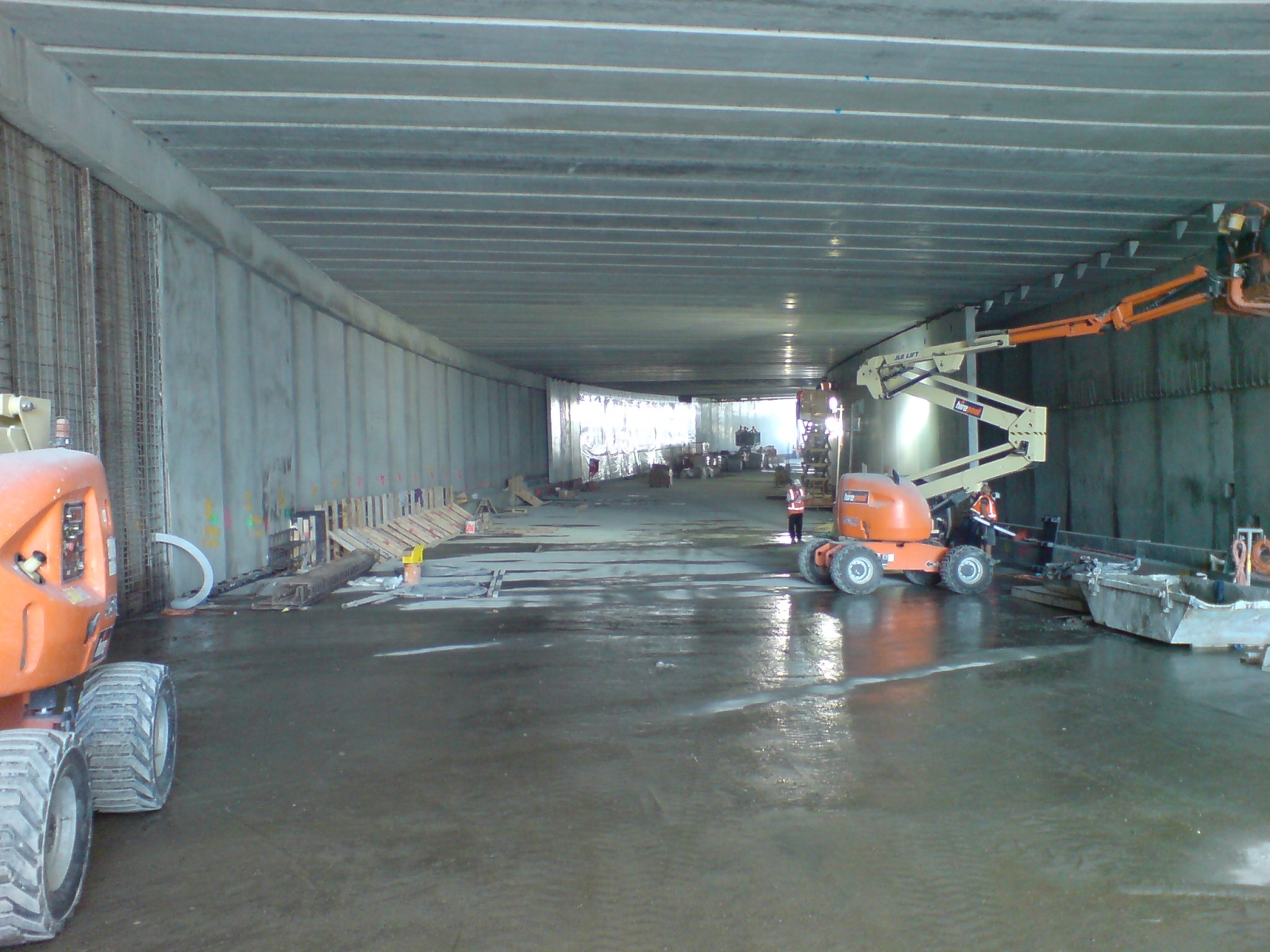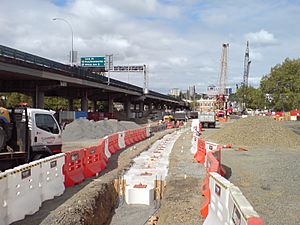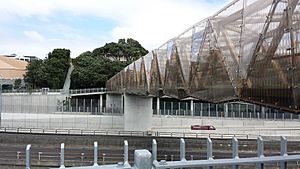Victoria Park Tunnel facts for kids
 |
|
| The tunnel under construction in 2012 | |
| Overview | |
|---|---|
| Location | Victoria_Park, Freemans Bay, Auckland, New Zealand |
| Coordinates | 36°50′49″S 174°45′11″E / 36.847045°S 174.753095°E |
| Status | Open to all traffic |
| Route | Auckland Northern Motorway |
| Operation | |
| Work begun | January 2010 |
| Owner | AT (Auckland Transport) |
| Technical | |
| Length | 440 metres (1,440 ft) |
| Number of lanes | 3 |
| Operating speed | 80 km/h (50 mph) |
| Width | 13.2m |
The Victoria Park Tunnel is a special road tunnel in Auckland, New Zealand. It was finished in 2012 and is part of New Zealand State Highway 1. This tunnel helps cars travelling north. It takes traffic off the old Victoria Park Viaduct, which now only carries southbound traffic. The tunnel is mostly built underneath Victoria Park.
Contents
Why the Tunnel Was Built
The Victoria Park Tunnel was built to help with traffic jams. Before the tunnel, the Victoria Park Viaduct often got very busy. This caused long delays, even outside of morning and afternoon rush hours.
The tunnel helps more cars get through this area. This means the Auckland Harbour Bridge can be used more easily. The project was first called 'Harbour Bridge to City'. Now, its official name is the 'Vic Park Tunnel'.
The tunnel cost about NZ$340 million to build. It is only for cars going north. It starts near a historic pub called the 'Birdcage'. This pub had to be moved so the tunnel entrance could be built. The tunnel then comes out northwest of the park. It connects to extra lanes on the motorway near St Marys Bay. The tunnel has three lanes and is 440 metres long. Building started in January 2010 and was planned to take four years.
How the Tunnel Was Built
Work on the tunnel began in early 2010. It started near the St Mary's Bay on-ramp. The historic Birdcage hotel was moved 40 metres away temporarily. It will eventually return close to its original spot. It will become part of a new public space.
By July 2010, all pipes and cables in the tunnel's path were moved. This cleared the way for the main construction. Workers removed about 160,000 cubic metres of soil from the tunnel trench. Over 100,000 hours of work were put into the project each month. This was a huge effort for a New Zealand road project.
The Rob Roy Hotel (also known as the Birdcage) was moved in August 2010. It was lifted onto special sliding rails. The move took two days and was jokingly called the "slowest pub crawl ever." It will eventually be placed above the tunnel entrance.
The Wellington Street on-ramp had to be closed for a few weeks. It was also closed for several months in 2011. This was needed to build the tunnel entrances and the new on-ramp.
By mid-2011, the project was ahead of schedule. Cars could use the tunnel as early as November 2011. All construction was finished by February 2012.
Extra Works Around the Tunnel
As part of the tunnel project, more lanes were added. These new lanes are between the tunnel and the Auckland Harbour Bridge. New noise barriers were also built. These barriers are 3 to 5 metres high. They are made of clear panels. This allows people to see between the motorway and the St Marys Bay cliffs.
A new pedestrian bridge was built at the northern end of the tunnel. It goes over State Highway 1. This bridge connects the eastern part of Westhaven Marina and the Western Reclamation. It also links to the 'Jacob's Ladder' stairway, which goes up to St Mary's Bay.
The project also included other improvements. Several old buildings in the construction area were repaired. Public spaces were also made better. In mid-2011, a new Skatepark was built. It replaced the old one that was removed for the tunnel work.
During construction, some interesting old items were found. These included a 19th-century pistol. Workers also found parts of old wharves and walls. These were likely used when Victoria Park was first created by filling in land.
Images for kids






